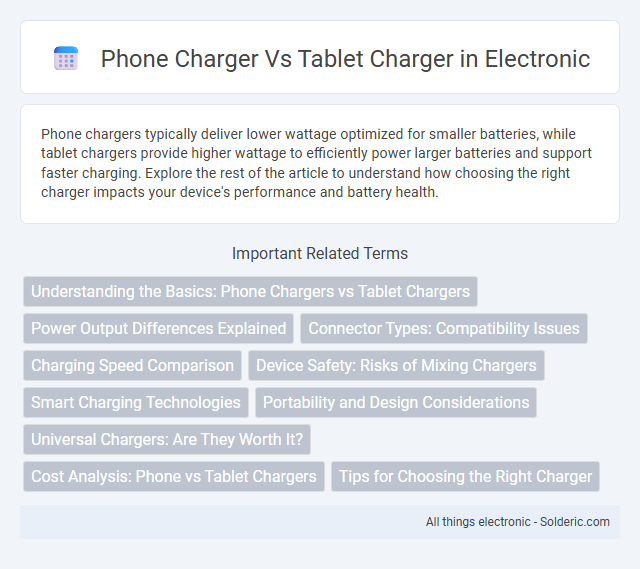Phone chargers typically deliver lower wattage optimized for smaller batteries, while tablet chargers provide higher wattage to efficiently power larger batteries and support faster charging. Explore the rest of the article to understand how choosing the right charger impacts your device's performance and battery health.
Comparison Table
| Feature | Phone Charger | Tablet Charger |
|---|---|---|
| Power Output | 5W to 20W | 18W to 30W or higher |
| Connector Type | USB-A, USB-C, Lightning | USB-C, USB-A |
| Charging Speed | Fast charge available (e.g., Qualcomm Quick Charge) | Faster charging optimized for larger batteries |
| Compatibility | Smartphones, small devices | Tablets, some laptops, large devices |
| Voltage | 5V standard, some support higher voltages (9V, 12V) | 9V to 20V common |
| Usage | Daily phone charging | Charging tablets and power-hungry mobile devices |
Understanding the Basics: Phone Chargers vs Tablet Chargers
Phone chargers and tablet chargers differ primarily in power output and connector type, with phone chargers typically providing 5 to 20 watts, while tablet chargers range from 10 to 30 watts or higher to accommodate larger batteries. Tablet chargers often utilize USB-C or proprietary connectors designed for faster charging speeds and higher voltage delivery compared to standard micro-USB or Lightning connectors found in many phone chargers. Understanding these distinctions ensures compatibility and optimal charging efficiency, preventing potential damage or slower charge times.
Power Output Differences Explained
Phone chargers typically deliver power outputs ranging from 5W to 20W, optimized for smaller battery capacities and faster charging cycles. Tablet chargers, on the other hand, often provide higher power outputs between 18W and 30W or more, accommodating larger batteries and enabling more efficient charging times. The increased wattage in tablet chargers ensures compatibility with tablets' higher voltage and current requirements, preventing slow charging or insufficient power delivery when used interchangeably.
Connector Types: Compatibility Issues
Phone chargers typically use USB-C or Lightning connectors, while tablet chargers may utilize USB-C, proprietary connectors, or higher-wattage versions of the same connector type, leading to compatibility issues. Using your phone charger on a tablet can result in slower charging speeds or failure to charge, as tablets often require higher power delivery not supported by standard phone chargers. Ensuring the connector type and power rating match your device is essential for safe and efficient charging.
Charging Speed Comparison
Phone chargers typically offer power outputs ranging from 5W to 30W, while tablet chargers commonly provide higher wattages between 10W and 45W, resulting in faster charging speeds for tablets. The increased voltage and amperage in tablet chargers enable more efficient energy transfer, reducing overall charging time compared to phone chargers. Compatibility with fast charging standards such as Qualcomm Quick Charge or USB Power Delivery also influences charging speed but varies based on specific device and charger models.
Device Safety: Risks of Mixing Chargers
Using a phone charger on a tablet or vice versa can pose significant risks to device safety due to differences in voltage, amperage, and connector types. Chargers designed for phones typically supply lower power output, which may cause slower charging or even overheating when used with tablets that require higher wattage. Your device's battery and internal circuits could be damaged over time if incompatible chargers are used regularly, highlighting the importance of using the manufacturer-recommended charger for each device.
Smart Charging Technologies
Phone chargers and tablet chargers utilize smart charging technologies such as Qualcomm Quick Charge, USB Power Delivery (PD), and Adaptive Charging to optimize power delivery and protect battery health. Tablet chargers typically support higher wattage outputs ranging from 18W to 30W or more, enabling faster charging compared to phone chargers that usually provide 5W to 20W. Integration of intelligent identification chips allows chargers to detect the connected device and adjust voltage and current accordingly, ensuring efficient and safe charging for both phones and tablets.
Portability and Design Considerations
Phone chargers typically prioritize compactness and lightweight design for maximum portability, often featuring foldable plugs and smaller form factors ideal for pocket or bag storage. Tablet chargers are generally bulkier with higher wattage requirements to support faster charging and power-hungry devices, often resulting in larger adapters and thicker cables. Design considerations for both optimize user convenience, but phone chargers emphasize everyday mobility while tablet chargers balance portability with robust power delivery.
Universal Chargers: Are They Worth It?
Universal chargers offer a convenient solution by supporting multiple devices, including phones and tablets, through adjustable voltage and interchangeable connectors. Their compatibility with a wide range of brands and models reduces the need to carry separate chargers, making them ideal for travel and everyday use. You can save space and avoid compatibility issues, but it's essential to ensure the universal charger delivers the correct power output for your device to prevent damage or slow charging.
Cost Analysis: Phone vs Tablet Chargers
Phone chargers generally cost less than tablet chargers due to lower power output requirements and simpler hardware designs. Tablet chargers often feature higher wattage and advanced fast-charging technologies, increasing their price compared to standard phone chargers. Your choice should balance cost with compatibility and charging speed needs for optimal device performance.
Tips for Choosing the Right Charger
Selecting the right charger depends on the device's voltage and current requirements to ensure optimal charging speed and safety. Your phone charger may not provide adequate power for a tablet, which typically requires higher wattage to charge efficiently without overheating or battery damage. Look for chargers with compatible output specifications, preferably those certified by manufacturers or adhering to USB Power Delivery standards for reliable performance.
Phone charger vs Tablet charger Infographic

 solderic.com
solderic.com